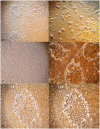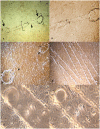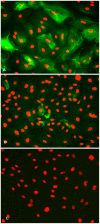Establishment and characterization of a buffalo (Bubalus bubalis) mammary epithelial cell line
- PMID: 22792341
- PMCID: PMC3392245
- DOI: 10.1371/journal.pone.0040469
Establishment and characterization of a buffalo (Bubalus bubalis) mammary epithelial cell line
Abstract
Background: The objective of this study was to establish the buffalo mammary epithelial cell line (BuMEC) and characterize its mammary specific functions.
Methodology: Buffalo mammary tissue collected from the slaughter house was processed enzymatically to obtain a heterogenous population of cells containing both epithelial and fibroblasts cells. Epithelial cells were purified by selective trypsinization and were grown in a plastic substratum. The purified mammary epithelial cells (MECs) after several passages were characterized for mammary specific functions by immunocytochemistry, RT-PCR and western blot.
Principal findings: The established buffalo mammary epithelial cell line (BuMEC) exhibited epithelial cell characteristics by immunostaining positively with cytokeratin 18 and negatively with vimentin. The BuMEC maintained the characteristics of its functional differentiation by expression of β-casein, κ-casein, butyrophilin and lactoferrin. BuMEC had normal growth properties and maintained diploid chromosome number (2n = 50) before and after cryopreservation. A spontaneously immortalized buffalo mammary epithelial cell line was established after 20 passages and was continuously subcultured for more than 60 passages without senescence.
Conclusions: We have established a buffalo mammary epithelial cell line that can be used as a model system for studying mammary gland functions.
Conflict of interest statement
Figures












Similar articles
-
Matrix-based three-dimensional culture of buffalo mammary epithelial cells showed higher induction of genes related to milk protein and fatty acid metabolism.Cell Biol Int. 2016 Feb;40(2):232-8. doi: 10.1002/cbin.10555. Epub 2015 Nov 15. Cell Biol Int. 2016. PMID: 26503422
-
Isolation, characterization, and EGFP expression in the buffalo (Bubalus bubalis) mammary gland epithelial cell line.In Vitro Cell Dev Biol Anim. 2013 Jan;49(1):1-7. doi: 10.1007/s11626-012-9557-1. Epub 2012 Nov 21. In Vitro Cell Dev Biol Anim. 2013. PMID: 23180034
-
Impact of Heat Stress on Cellular and Transcriptional Adaptation of Mammary Epithelial Cells in Riverine Buffalo (Bubalus Bubalis).PLoS One. 2016 Sep 28;11(9):e0157237. doi: 10.1371/journal.pone.0157237. eCollection 2016. PLoS One. 2016. PMID: 27682256 Free PMC article.
-
Establishment and characterization of a spontaneously immortalized porcine mammary epithelial cell line.Cell Biol Int. 2006 Dec;30(12):970-6. doi: 10.1016/j.cellbi.2006.06.023. Epub 2006 Jul 12. Cell Biol Int. 2006. PMID: 16919976
-
Functional analysis of recombinant buffalo lactoferrin and monoferric lobes and their cytotoxic effect on buffalo mammary epithelial cells.Biometals. 2019 Oct;32(5):771-783. doi: 10.1007/s10534-019-00209-0. Epub 2019 Sep 25. Biometals. 2019. PMID: 31555927
Cited by
-
Novel Insight into the Role of Squalene Epoxidase (SQLE) Gene in Determining Milk Production Traits in Buffalo.Int J Mol Sci. 2023 Jan 26;24(3):2436. doi: 10.3390/ijms24032436. Int J Mol Sci. 2023. PMID: 36768756 Free PMC article.
-
In vitro culture and evaluation of bovine mammary epithelial cells from Ukraine dairy cows.Iran J Vet Res. 2021 Winter;22(1):65-71. doi: 10.22099/ijvr.2020.37714.5508. Iran J Vet Res. 2021. PMID: 34149858 Free PMC article.
-
Successful editing and maintenance of lactogenic gene expression in primary bovine mammary epithelial cells.In Vitro Cell Dev Biol Anim. 2023 May;59(5):316-330. doi: 10.1007/s11626-023-00762-6. Epub 2023 Jun 6. In Vitro Cell Dev Biol Anim. 2023. PMID: 37278965 Free PMC article.
-
Evolutionary and Association Analysis of Buffalo FABP Family Genes Reveal Their Potential Role in Milk Performance.Genes (Basel). 2022 Mar 28;13(4):600. doi: 10.3390/genes13040600. Genes (Basel). 2022. PMID: 35456406 Free PMC article.
-
Tissue-Specific Expression of Circ_015343 and Its Inhibitory Effect on Mammary Epithelial Cells in Sheep.Front Vet Sci. 2022 Jun 28;9:919162. doi: 10.3389/fvets.2022.919162. eCollection 2022. Front Vet Sci. 2022. PMID: 35836501 Free PMC article.
References
-
- “Water Buffalo An asset undervalued”. United Nations Food and Agriculture Organization. Retrieved on 2011–09–15. 2000. FAO website: http://www.aphca.org/publications/files/w_buffalo.pdf.
-
- Martinet J, Houdebine LM, Head HH. Biology of Lactation. Paris: INRA publication. 670 p. 1999.
-
- Larson BL. Larson BL, Anderson, RR, editors. Biosynthesis and cellular secretion of milk. 1985. pp. 129–163. Lactation. Ames: The lowa State University Press.
-
- Rosen JM, Jones WK, Campbell SM, Bisbee CA, Yu-Lee LY. Czech MP, Kahn, CR, editors. Structure and regulation of peptide hormone responsive genes. Vol 23. 1985. New York: A. R. Liss. Proceedings UCLA Symposium on Membrane Receptors and Cellular Regulation. (385–396).
-
- Levine JF, Stockdale FE. 3T3-L1 adipocytes promote the growth of mammary epithelium. Exp Cell Res. 1984;151:112–122. - PubMed
Publication types
MeSH terms
Substances
LinkOut - more resources
Full Text Sources
Other Literature Sources
Research Materials

